 |
 |
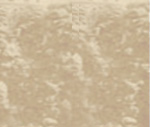 |
|
||
| main :: biography :: texts :: manuscripts :: photographs :: drawings :: squeezes :: publications :: about | ||
|
1894 Report of Mr. Supervisor over the Excavations in Chersonesos Reconnaissances in the south-west corner
There, because of the Military engineering department has constructed a new line of batteries towards Streletskaya bay, and the last year excavations were finished, current archaeological excavations had no opportunity to move forward in front of the fortifying works, which were arranged in a hurry, applying railway and cars for ground mounds, and had to be restricted only to shallow investigation of the most important points in this area of the ancient city site and, mainly, to discovering questions connected to the city gate and defensive ditch in front of the west wall; it appeared that there were no ditch at the south wall, which was constructed atop the ridge of sizable hill, which housed, as it was discovered by 1891-1893 excavations, large necropolis. Unfortunately, the part of the south-west extremity where the main city gate should be located according to A. L. Berthier-Delagarde's opinion, appeared to be in so chaotic state, that the reconnaissances made there did not lead to desired results in terms of discovering of the site of the aforementioned gate. The circumstance that the city waterpipe enter into this place, that from this point wide road starts (it is still determinable and is limited by stone fence on both sides), remains of which allows the one to trace the direction of this road and its forks over many versts, and, finally, that the front part of big marble lion is discovered in this corner, in the closest vicinity of the flanking tower, gives us all the reason to consider A. L. Berthier-Delagarde's hypothesis well grounded, especially as there is no other and more convenient place for the gate and road along the remaining length of the well-preserved site of the west city wall, as long as the northern sea coast, as it would be necessary to lay the road not atop the hill but along the slope of it. In the course of time, when the whole west defensive wall is investigated, with the large necropolis in front of it, the problem of the city gate will find its final solution. The discovered fragment of big marble lion, probably one of the two sculptures decorating the main gate, was heavily damaged, seemingly simultaneously with the devastation of this strategically important point where the main flanking tower and city gate were located. The breast is 2 arch<ines> and 6 versh<oks> in diameter, the height from the top of the head to the beginning of the foot, which are cut off, is 1 arch<ine> and 6 versh<oks>, forelegs and hind legs are missing, the head is turned aside (to the left, if we put the lion atop assumed gate facing Streletskaya bay); on top of the head there is carved circular slot 1" deep and 1 ¾" in diameter, for unknown purpose. Regarding the ditch in front of the west wall, the excavations were started at the very wall, where it preserved well at the foundation, and covered the area of 10 sazh<enes> and 2 arch<ines> occupying the strip as wide as 5 sazh<enes> and discovered, within bedrock, footing of the ditch, of different depth and width depending on the direction of the bedrock. The ditch was uninterrupted along the whole uncovered area; the layer of ground atop was as deep as 5 ½ arch<ines>. The batteries' builder, military engineer M. I. Gariburda, who hypothesized that there should be a ditch in front of the west wall, which was constructed simultaneously with the south wall, atop inconsiderable and sloping hill and acknowledged that the excavations undoubtedly uncovered the bottom of the ditch that was cut into bedrock.
There is an altarless church uncovered as far as 56 sazh<enes to the e<ast> from the above-mentioned west wall and 21 1/3 sazh<enes> far from the northern line of the area which is beyond the reach of the archaeological reconnaissances; it is 11 arch<ines> long and 7 ¼ arch<ines> wide, is constructed of rubble with clay, and has five destroyed tombs, 4-4 ½' deep each, under the floor. There is no worked marble, even in the form of smallest splinters, which is a very rare phenomenon for the altarless churches of Chersonesos. The soil removed from the tombs contained: fragment of thin bronze icon lamp chain with hook; 4 bronze buttons in the form of closed bells; 5 broken glass bracelets of very rough workmanship, and bronze coin of the emper<or> Romanus II, cast for Chersonesos.
Reconnaissances in the south-east corner
There are remains of thick but narrow wall uncovered when excavating the area aimed for building warehouse of antiquities in 1892. It was laid of fine stone and mortared with lime mortar, in result of which unusually compact, almost solid mass developed there; the workers had to invest unusual efforts to clear this area. This wall bears traces of facing with ashlars, which, as these are considered valuable material, were undoubtedly used for different buildings in the time when the wall was already ruined. Due to the lime that left white spot on the surface of the ground, it appeared possible to determine the approximate subsequent direction of this wall as long as its crossing with the new monastery fence. This wall is interesting because it was by some reason destructed along its full length, whereas the defensive wall that more than once protected the city from the enemies kept considerable height, in many places almost full size of it, till 1893 when the most important part of the wall was destroyed when building batteries. In this connection, the most careful investigation was performed, in the year under report, of this area of the ancient city site, especially since from there, from the sea coast, it was easy to continue excavations up along the slope to connect with 1888 excavations, at place where workshop of the ancient coroplast with multitude of earthenware moulds was uncovered, as described by V. K. Malmberg in the VII volume of Mater<ialy> po arkheol<ogii> Rossii (Materials for the archaeology of Russia).
See the plan (Fig. 71) as attached with exact indication of direction of walls and location of the huts sheltered on both sides of it, which undoubtedly date to the late Byzantine period, when the ancient wall in this area of the city already lost its strategic significance and, being half-ruined, was used only as support for various shops and warehouses. 8 arch<ines> far from the corner of the monastery fence, at acute angle and inclining to s<outh>-e<ast>, there was ancient city wall (no. 1) with the same stonework of fine rubble coated with the lime that was described above, faced on both sides with big slabs of hard steppe stone carefully adjust to each other. The main defensive wall in the n<orth>-w<est> corner of the ancient city site was faced mainly with slabs of soft stone and of bigger size, as much as 4 arch<ines> long. When this wall goes 3 arch<ines> in the above direction and becomes as much as 4 arch<ines> and 10 versh<oks> wide, it abuts some square building (no. 2) , 12 х 12 arch<ines>, with 3 arch<ines> wide exit in its n<orth> wall, which was blocked with thin wall mortared with clay, and 4 pillars inside, in the corners, which are laid of solid slabs 1 ¾ х 1 arch<ine> and 5 versh<oks>, with the socle as much as 5 versh<oks> high. Three of these pillars remained only up to the height of 1 ½ arch<ine>, and the 4-th one, constructed of 4 slabs in the n<orth>-e<ast> corner, as high as one sazhene. Point а refers to where drainage canal, semicircular in cross-section, runs through the wall. This wall is excellently preserved and makes an impression of beautiful and very strong construction. The whole space in between of obtuse angle composed by this wall and the square building was filled with refuse as shells. As building no. 2 is located in that part of the coast where the distance from the bay is minimal (13 arch<ines>, the whole are undoubtedly drift, because of which the whole coast that looks s<outh> rises annually to the detriment to the width of the bay); and as it is located at the apex of obtuse angle formed by the ancient wall and equipped with 4 pillars of excellently dressed stones and wide (3 arch<ines> far) exit to the inner part of the ancient city site, it may probably be interpreted as an ancient dug-in quay, which could be approached by boats. The bay has been shoaling continuously, as well as destruction of the north coast of Chersonesos, which is subjected to the influence of waves and winds, so there is no doubt that the direction of the ancient wall as can be seen on the plan corresponds, to this or that extent, to the former contour of Karantinnaya bay, this trading port of the ancient Chersonesos. Farther to e<ast> , the wall appeared damaged on its n<orth> side, having 5 rooms adjoining it (nos. 3, 4, 5, 6, 7), which undoubtedly were warehouses, windowless, with deeply sunken floors, two of which, in rooms nos. 5 and 6, are of brick and of excellent preservation. The bricks are thin and square. When building these warehouses, they laid thick wall limed with earthenware to block the wide entrance which was the communication between the city and the bay. Excavations in room no. 7 discovered remains of brick kiln (в) with big pithos near it (г), 4 arch<ines> and 14 versh<oks> in diameter, that was covered with stone slab and sunken to the ground as deep as the mouth. Farther, there is an ancient tower (no. 8) with the entrance from the city, 2 arch<ines> wide, located within the angle formed by the wall turning n<orth>. Lower than the floor, there was drainage canal of stone slabs, quadrangular in cross-section, that went under the wall in point б. Here, the defensive wall preserved less of its height than in other places, and above there was a street of the Byzantine period, going down through the room in the tower, and under the street was the second ancient drainage canal д. It is known that there are drainage canals laid under every streets of upper Chersonesos, even in two lines under the main street.
In 1894, we had to restrict the excavations to uncovering outer side only, that is the part of the coastline where no building could exist in the period when the defensive wall was used according its purpose, because the tower (no. 8), as it can be seen from the plan, faced the rear of the enemy, who dared to attack the right broken line of the wall. After competent persons put the above considerations, it is very interesting to uncover, in this area, the few rooms that adjoins the defensive wall (nos. 9, 12, 14, 15), and even two rooms separated from the latter (nos. 11 and 13). Walls of these rooms are laid of fine stone with clay, though in some places there are ashlars taken from the destroyed defensive wall. Room no. 15 contained: bronze padlock of original form, decorated with rough horses on top of the arched handle (s<ee> Fig. 72) ; glazed earthenware vessel with its long narrow neck broken off and repaired:
In this place, there are cultural layers about 5 arch<ines> deep from the socle of the ancient wall to the surface of the ground; the wall that remained is 3 arch<ines> and 3 versh<oks> high and 3 arch<ines> and 7 versh<oks> thick. The socle of the wall is 1 ½ arch<ines> deeper than the Byzantine city foundations. There are three trading warehouses nos. 16, 17 and 18 located nearby, opposite to room no. 14, at the e<ast> of the wall. In the n<orth>-e<ast> corners of the first and second rooms, two big pithoi were sunken; these are as high as 3 ¾ arch<ines> each, greatly damaged and covered with soil. The closest t the wall room no. 16 contained, beside pithos: glazed plate, broken and greatly damaged by fire, 1' 1" in diameter, with image of eagle and griffin attacking each other; baked round flat bread, adust, and skeleton of adult man, also adust.
Big corner room no. 18 has the same exit to narrow passage as no. 17 does, and was used as trade warehouse. There were 7 pithoi, 1 ½ to 3 arch<ines> high, sunken to ground as deep as the neck, and faced with sea grass from the outside. (North wall of the room remained as high as 1 sazh<ene>). At the door, there was stone slab that was used as a stair; 2 arch<ines> far from the s<outh>-e<ast> corner there was well, arranged in the wall, quadrangular at the top, 1 х ¾ arch<ine>, faced with slabs, and round at the bottom, below the wall, 1 arch<ine> and 6 versh<oks> in diameter, faced with rubble but not cemented, which proves that it was ice-box, especially as the water appeared at the depth of 5 ¾ arch<ines>. This room, as well as the neighboring ones, was destroyed undoubtedly by fire: all the artifacts uncovered from it are greatly damaged by fire, and there is adust skeleton of child uncovered at the east wall, they probably did not have time to save him. Big globular pithos, 5 ¼ arch<ines> in diameter, which is uncovered absolutely intact, appeared to have circular lead rivet on one side, which covered small punched hole.
Beside the above mentioned seven pithoi, the following artifacts were found:
On the east, this room adjoins street of the upper city that goes down to the bay. In one direction with the ancient wall, 1 sazh<ene> above sockle, there was drainage canal, 13 versh<oks> wide and 10 versh<oks> high, laid of stone slabs and going above the wall (no. 21) of a house in the lower city. Apart from the mentioned above antiquities, the following object were uncovered also when excavating the s<outh>-e<ast> extremity of the ancient city site in the year under report:
Inscriptions: fragment of marble slab, 1 ¼" thick, with 8 letters in two lines, of Greek inscription. The letters are 1" high. Handle of earthenware amphora with damaged Greek inscription (it possibly is the name of manufacturer). Fragment of earthenware sinker in the form truncated pyramid with Greek inscription below: Pottery. Egg-shaped pithos of medium size, 1 ½ arch<ine> high. Single-handled earthenware pitcher, 9" high, the spout is missing. Earthenware pot, 4" high, blackened by soot. 6 shards of black slip earthenware pottery, without drawings. Earthenware plug for amphora, of usual form. Earthenware cork with knob in the middle and hole in it to pour liquid out. Broken black slip earthenware lamp with high foot. Fragment of black slip lamp. Plain lamp of red earthenware. Lamp with relief image of sheep stepping right. Broken glazed plate of medium size. Its shards received different colors because of fire. 2 glazed single-handled juglets, 2-2 ½" high. 9 bottoms of glazed bowls with images of: cross, roughly-made warrior, two birds sitting one opposite to another, front part of monster bird, bull running to the right, griffin stepping left, head of panther with the tongue hanging out, bird of very rough workmanship, vine with bunch of grapes; 1786 bottoms and shards of earthenware glazed pottery, both plain and ornamented, but without drawings. Glass round-bottom bottle, 1 ¼" high. 7 stems of glass wineglasses. Cup of sheet copper, 10" high and 1 ½' in diameter, greatly damaged by fire. 4 fragments of marble mortars. Stone mortar, 2' high and 1 ½' in diameter. Weapons. 9 bronze arrowheads. 2 big throwing stones for ballistae. 16 small throwing stones for catapults. The throwing stones were uncovered along the defensive wall. Instruments, tools, and implements. Big iron axe, similar to the axes used by the Tatars of the south coast <of Crimea>. Iron axe, damaged at the top. Iron double axe similar to the ones used by the Greeks when building ships. Bone handle for knife, with fragment of blade. Handle of small knife, with hole. Hone with hole. 3 hones without a hole. Iron broken padlock. 3 quernstones for hand mills. Iron corner piece with two bolts.
Fishing accessories. 73 sinkers for fishing nets in the form of truncated earthenware pyramids, with holes in top part. 3 sinkers with ill-identifiable images. 10 earthenware sinkers in the form of cylinders. 9 ball-shaped earthenware sinkers. 2 flat earthenware sinkers with holes on each end and groove to protect cord from friction. 12 big bronze fishhooks (for fishing flounder). Needlework accessories. Bone piercer, 5" long, with one side flat, that becomes as wide as ¾"; 2 small bone piercers. Big bronze needle. Gaming accessories. 2 bone checkers in the form of flat circles with cross-shaped slit in the face side. 2 earthenware balls. 3 shells (not local).
Horse harness. Bronze closed bell, of excellent preservation (Fig. 77). Church utensils. Half of bronze reliquary cross, 2 ¼ х 1 ¼'', with relief image of Crucified Savior; the work is rough. Bronze cross, 1¾ х 1", of rough workmanship, with an eyelet (Fig. 78). . Bronze cross, 1 х ¾", of good workmanship, with an eyelet. Bronze cross, broken, with rosette in the middle and each tip ending with ball. Cross of many-colored marble, 3/16 х 4/16'', broken. 20 bronze buttons in the form of closed bells. Earthenware thurible alike flowerpot, with 4 holes below and 12 holes around. It is possible to think that this is lid for bronze censer, similar to that uncovered in room no. 18. Accessories of apparels and toilet. Bronze finger-ring, of rough workmanship. 24 round and oval glasses for finger-rings and medallions. 296 shards of glass bracelets. 2 shards of glass finger-rings. 2 pendants in the form of bronze swords. 7 carnelian beads. 18 beads of multicolored glass. 2 beads of multicolored paste. Broken silver square plate, 1 ¾ х 1 ¾, with traces of carving, decorated with garnets in the corners and hawk's head at the front, with the eye which, according to the empty socket, also consisted of garnet. Only one nail remains of the nails that fastened the plate, probably to a belt. 2 bronze belt buckles of rough workmanship. Bone round button with eyelet. Bronze griffin, 2'' high, with raised wings, leaning on one thick paw; there is projection, 3/16", at the bottom of it, by which the griffin probably was fastened to casket's corner to be leg of the latter. Square bone plate with roughly carved image of an eagle with the head turned back, for a casket. 2 fragments of carved bone decorations for caskets. Building parts from churches and houses. Small carved marble capital. There are oval slits on the top, on each of four corners. 4 fragments of marble cornice 11" wide. Total length of all fragments is 14'. Fragment of marble cornice, 10" wide, with cross and acanthus leaf. Fragment of marble door with carved ornament in the form of crosses of different form. 5 small fragments of marble slabs. 3 fragments of thin marble slabs: white with black spots, dark green with light green spots, and greenish red. 2 big fragments of round marble columns. Fragment of white marble faceted column, 10" long and 5" in diameter. Fragment of column of pink (Balaklava) marble 10" in diameter. 4688 pieces of smalt of different colors and with gilding, beached by the sea (from the basilica uncovered in 1853 by the count A. S. Uvarov). 4 fragments of windowpanes. 6 fragments of opus signinum (uncommonly strong plaster that consists of lime and crushed brick). Artifacts of unknown purpose. Flat glazed earthenware circle, of green color, with hole. 2 flat earthenware circles with holes. Bronze plate, 2 2/8 х 1 х ¼", with flat oval boss, with ornament carved into surface. Earthenware end-piece with reach-through hole and wide bent spout similar to parrot's beak. Chiseled bone ring, similar to the rings used for napkins nowadays. Such rings are often found in tombs of the Roman period. Iron pointed end-piece 6" long. Raw material prepared for making artifacts. Piece of pumice. 2 pieces of tar (pitch). Animal bones and shells. 20 wild boar's tusks. Wild boar's jaw with tusk. Bull's horn. 2 horns of domestic goat. Dolphin's skull (excavated from the depth of 2 arch<ines>). Bone from leg of cock, with spur. Half of beautiful big flat shell.
Coins and votive symbols (433 spec<imens> total). Of Chersonesos of autonomous period:
head of Artemis wearing turreted crown, facing right, with countermark in the form of club behind - unrecognizable object, which could not be deer like at Burachkov, <Op. cit., plate> XIV, №№ 11 и 12. Head of Artemis in wreath, facing to the right - lying deer, to the left, with Excavations in the necropolis
No. 429. The tomb is laid of stone slabs, with roof having two bays
(Fig. 79)
.The tomb is 9' 4'' long, 6' 4" wide, its maximal height is 5' 1", minimal height is 3' 9", the slabs are about 1' 6" thick. In the back side, opposite to the entrance, which is tightly blocked with slab, 3' 9" high and 2' 8" wide, there were carved two (three in each of side walls) niches of quadrangular form, 1' 6" high, 1' 2" wide, and 1' deep. The tomb is oriented with its exit to west; the distance from its east, back side to the w<est> defensive wall is 2' 4", and from the s<outh>-e<ast> corner to the turn of the defensive wall (where round flanking tower is located) there are 43 sazh<enes> and 4' 8". This is cremation type burial. In the tomb, along three sides of it, there were 8 earthenware urns: one double-handled and 7 single-handled, and in the niches there were: 3 single-handled earthenware juglets; 2 earthenware bowls; fragment of terracotta cock (its breast and legs are missing); 28 earthenware lamps, of which: one with a star on top and depressed Greek name
Apart from cremated from the urns contained: 10 glass balsamaria, of which 4 have flat bottom, 5 round bottom, and one is globular with narrow neck, and glass bottle, 2 7/8" high, in the form of beautiful double-handled amphora (Fig. 81). This form of glass vessel is also met for the first time. Two gold hollow finger-rings, with oval convex carnelian inset in one of them (Fig. 82) ; the stone fell out of the socket in the other finger-ring, because probably of fire, and was not found; thin but solid gold finger-ring with oval carnelian gem with carved image of Heracles (?) standing; small gold finger-ring in the form of two finger-rings put together, the stones from two oval sockets fell out and were not found; two gold child's finger-rings, one has glass insert, though the glass or stone fell out from the socket of the other one and were not found; solid gold ring in the form of snake, of rough workmanship (Fig. 83) ; opal (?) finger-ring, smooth on top and from inside, though ribbed around (Fig. 84) No stone finger-ring were found in Chersonesos before. Gold tube (Fig. 85) 7/8" long, decorated with stars and circles, with eyelet on either end; it was obviously closed on either size. Such tubes of unknown purpose, of silver and bronze, are often found in tombs, but only one gold artifact has been found, in 1890, when excavating the ancient city site (as described and depicted in 1890 Otchёt Arkheologicheskoy Komissii [Archaeological Commission report], p. 32). Flat oval gold badge, 1 3/8" х 1", with very rough, impressed image of young Heracles, standing, with club in his right hand. On either side of the head, there are two holes encircled with cord-shaped border, in which certainly were placed either garnets or enamels that fell out because of the fire. At the bottom, on both sides there are X-shaped patterns.
20 gold sewing badges: 3 big circular <badges> with image of star; 8 similar but smaller <badges>; 3 big circular <badges> in the form of pointed caps; 2 similar but smaller <badges>; 3 <badges> in the form of pyramids of balls, and one small square <badge> with image of standing deer. Elongated, ribbed gold bead; jet pierced bead in the form of barrel with the ends framed with gold; 25 pieces of thin sheet gold; bronze amulet, of extremely rough workmanship, depicting naked figure of man in Phrygian helmet, with his right hand holding globe, and with eyelet on the back; bronze ring with knobs; small silver earring; small silver brooch; small oval carnelian gem, with carved fish; oval glass gem with image of Eros; plain glass insert; glass circle with hole in the middle. Pendants: carnelian one, amphora-shaped, damaged; of glass, in the form of bunch of grapes, damaged; 2 of light green paste, depicting unknown object; of the same paste, phallus-shaped, and of carnelian, in the form of circular bead on silver wire with loop. Beads: 10 pieces of carnelian; 2 of chalcedony; 10 of amber; 8 of jet; 9 glass shard of multicolored paste, and 18 of glass. 4 bronze coins of Chersonesos (Burachkov, Sbornik materialov i pr. [Collected materials et al.], pl<ate> XVI, no. 90, but with the year 78, that is AD 54), bronze coin of Chersonesos, of bad preservation, <like in Op. cit.,> no. 96, but struck by another die, and without first three letters of the city's name, and no. 103, of extremely bad preservation. Taking the find of a coin, of good preservation, with the last year of the emperor Claudius I's reign, one can date the tomb to the second half of the first century AD. Both the construction and the finds put this monument to the group of the most interested tombs discovered in Chersonesos. Unusual safety of the tomb located within the distance of one archine from the defensive wall only demonstrates that the wall was constructed earlier than the tomb, otherwise the latter could not remain absolutely undamaged. No. 430. This tomb is laid of stone slabs, it is 3 arch<ines> long, 1 ¾ arch<ine> wide, and 1 arch<ine> deep, and is completely destroyed. It is oriented with the entrance to w<est> and is located 3 sazh<enes> far from the previous tomb. Three single-handled earthenware urns contained cremated bones and 10 pieces of thin sheet gold. The soil removed from the tomb contained small earthenware bowl and plain earthenware lamp. No. 431. This tomb is constructed of big roof tiles and is destroyed. The soil removed from the tomb contained: small bronze coin of Panticapaeum (Burachkov, <Op. cit., plate> XXI, 119) and small narrow-neck vessel without handles, of black earthenware. No. 432. This catacomb is located 4 sazh<enes> far to the w<est> from tomb no. 333; it is 3 arch<ines> long, 4 arch<ines> and 6 vesh<oks> wide at the entrance, and 2 ¾ arch<ines> wide at the rear wall, and 2 arch<ines> and 6 vesh<oks> high. The entrance, 1 х 1 arch<ine>, is cut at the height of one archine from the footing; it was covered by slab that was discovered moved away, and the catacomb was filled with mud of soil and rainwater that penetrated inside. There are niches carved into three walls (1 arch<ine> 6 versh<oks> deep and 1 arch<ine> high), with bones stacked on with their ends towards the wall and inside the catacomb, and separated from the niche edge by low wall of fine stone. There were the following artifacts uncovered amidst the bones: glass flat-bottom balsamarium, 2 ¼" high; end of woman's plait, and bronze coin of Valentinianus I proving that the catacomb (it was undoubtedly of the most ancient origin, s<ee> the description of catacomb no. 402) had been used for funerals in the late fourth or, more likely, in the early fifth century AD, as discovered coin was obviously in circulation for a long time. No. 433. This crushed double-handled earthenware urn was located at the very defensive wall. In the urn, apart from cremated bones, there were 3 pieces of thin sheet gold and glass round-bottom balsamarium. No. 434. This tomb, laid of stone slabs and destroyed, is located 5 arch<ines> fare to south from tomb no. 429. It contained: 3 single-handled earthenware juglets; single-handled earthenware cup; plain earthenware lamp; 6 glass round-bottom balsamaria; bronze bracelet; broken bronze brooch; big bronze belt buckle; bronze hair pin of rough workmanship; bronze toy-bell; silver tube with eyelet on either end; 3 bronze pendants in the form of axe and two picks; 2 chalcedonic amphora-shaped pendants; 2 jet pendants, and beads: 2 of rock crystal, 2 of chalcedony, 4 of carnelian, 4 of jet, 2 of amber, and 14 of glass. No. 435. This stone coffin is 1 arch<ines> and 11 versh<oks> long, 12 versh<oks> wide, and 9 versh<oks> high, with lid that laid aside. The distance from the defensive wall is 1 arch<ine>. There was nothing found in the coffin except for ground and rotten bones. This is the third stone coffin discovered in Chersonesos. No. 436. This tomb is faced with roof tiles and destroyed. The distance from the defensive wall is 2 sazh<enes>. The tomb contained nothing but shards of black slip earthenware plate. No. 437. This tomb is laid of dressed slabs, of very careful workmanship. It is 2 arch<ines> 10 versh<oks> long, 1 arch<ines> 4 versh<oks> wide, and 10 versh<oks> deep. Although top slabs were uncovered in situ, in the grave there was nothing but bones and silver, well preserved coin of the Roman emper<or> Decius (249-251). No. 438. This tomb was carved into bedrock and faced with ashlars from Inkerman from inside; it is 5 arch<ines> long, 3 ½ arch<ines> wide, and 2 arch<ines> 10 versh<oks> high, with the exit to e<ast> and 8 niches, 9 versh<oks> high and 3 versh<oks> wide each; 2 niches are located opposite to the entrance and 3 in either side wall. There were no top slabs, and the tomb was filled with ground, fine stone and multitude of bones. Removed ground contained: pair of bronze bracelets; big bronze brooch; 2 small bronze brooches; 2 small bronze mirrors; small bronze toothed medallion; bronze tube with eyelet on either end; plain bronze finger-ring; 2 small bronze bells for a necklace; 2 bronze rings for a necklace; 8 bronze belt buckles an small bronze shoe buckle.
No. 439. This underground tomb is faced with fine stone and contained one skeleton with silver, expandable, heavily damaged rings put on the hands and legs. There are 20 fine beads of multicolored glass uncovered from the soil.
No. 440. This underground tomb is faced with fine stone; it contained cremated skeleton, and was located to the right from catacomb no. 432. The finds: pair of gold earrings, of excellent preservation, in the form of disk decorated with wreath, circles and round garnet in the middle, with pendants in the form of double-handled amphora, bottom of turned upside down (Fig. 89) Silver finger-ring, damaged by fire, with carnelian gem with carved image of Pegasus stepping left (Fig. 90) ;8 jet pierced beads for bracelets; beads: one of carnelian, one of amber, one of blue glass, and 6 of multicolored paste. No. 441. Underground tomb is faced with fine stone and contained cremated skeleton. The finds: pair of small earrings of gold badge in the form of rosette (Fig. 91);
No. 442. Underground tomb is faced with fine stone and contained child's burial, accompanied with: pair of earrings in the form of circular convex badges with hook on the rear side;
Nos. 443-446. Four underground tombs are faced with fine stone; each contained one bronze coin: of Chersonesos (Burachkov, <Op. cit., plate> XVI, 96 and 117); of Gepaepyris (Burachkov, <Op. cit., plate> XXVI, 94), and of one of the Bosporan kings, of very bad preservation. No. 447. This underground tomb is faced with fine stone and contained child's burial, accompanied with: single-handled earthenware juglet and pair of small bronze earrings in the form of thin rings with faceted beads on either end. No. 448. Underground tomb is faced with fine slab. It contained: single-handled earthenware juglet; small earthenware bowl, 5" in diameter at the top, and iron knife blade. No. 449. The tomb is constructed of stone slabs; it is destroyed and filled with ground and fine stone. It contained: 9 earthenware lamps, two of which with relief image of bull running left and Eros stepping left; 2 single-handled earthenware juglets; small earthenware bowl, 4 ½" in diameter at the top; bronze belt buckle; bronze brooch of rough workmanship; child's bronze bracelet; broken straight bronze key; bone chiseled lid for box, 1 ½" in diameter; bone ribbed finger-ring; small grinding stone with hole; terracotta pendant in the form of truncated pyramid; 3 amber beads; carnelian bead; glass shard bead; 7 beads of black paste and 7 glass beads. No. 450. This crushed single-handled earthenware urn contained, apart from cremated bones, 6 pieces of thin sheet gold. No. 451. This catacomb with collapsed ceiling is covered with soil and stone; it is 4 arch<ines> 9 versh<oks> long, 3 arch<ines> and 4 versh<oks> wide, and 2 arch<ines> 10 versh<oks> high; it contains no niche and is of very rough workmanship. Removed soil contained: 2 earthenware single handled juglets; 3 earthenware single handled cups; earthenware saucer; 3 plain earthenware lamps; 2 gold impressions of coins with well preserved busts of the emperors Hadrian and Sauromates II (?); bone awl; small grinding stone with a hole; 2 bronze bracelets of rough workmanship; bronze belt buckle; 3 small bronze shoe buckles and 2 silver coins of the emper<ors> Maximinus (235-238) and Gordianus III (238-244). No. 452. Catacomb with collapsed ceiling is filled with soil and stone; it is 5 arch<ines> long, 2 arch<ines> and 10 versh<oks> wide at the entrance, and 4 arch<ines> at 6 versh<oks> wide at the rear wall, and 2 arch<ines> and 10 versh<oks> high. The entrance hole is 1 arch<ine> and 2 versh<oks> high, and 1 arch<ine> wide, it faces s<outh>. Removed soil contained: 5 gold impressions of coins, of bad preservation, one with image of bust probably of the emper<or> Alexander Severus; 4 damaged earthenware saucers with high foot; 6 single-handled earthenware cups; 4 single-handled earthenware juglets; 9 plain earthenware lamps; bronze belt buckle; bronze bracelet; thick bone ring, of unknown purpose; 5 beads of multicolored paste, of elongated form, and 6 round ones, and 2 bronze coins of Chersonesos (Burachkov, <Op. cit., plate> XVI, 106 and 108). No. 453. Underground tomb with burial of child is laid of fine stones. It contained: gold sewing badge with punched image of rosette; similar artifact with image of flower; small bronze bracelet; pair of small silver earrings; 20 beads in the form of flat circles of dark blue glass, and 2 bronze coins of Chersonesos (Burachkov, <Op. cit., plate> XVI, 106 and 118). No. 454. The underground tomb is laid of fine stones. It contained: bronze circular mirror, 2" in diameter, bronze belt buckle, and bronze coin of Chersonesos (Burachkov, <Op. cit., plate> XVI, 106). No. 455. Similar construction, that contained: small bronze earring; 4 teeth of unknown animal with holes in roots for hanging; 5 amber beads, and 10 glass beads. No. 456. Similar construction, that contained: pair of small bronze earrings; pair of small bronze bracelets; small bronze shoe buckle; bone circle with hole; 2 big pierced beads of chalcedony, damaged; ribbed carnelian bead; 17 beads of gray paste, and 80 beads, very fine, of light green glass. No. 457. Similar construction, that contained: bronze belt buckle and small grinding stone with a hole. No. 458. Similar construction, that contained: oval gold leaf for covering mouth, 2" long, with impression of the face side of Roman imperial coin in the middle, and damaged earthenware saucer with high foot. No. 459. Similar construction, with burial of child. It contained 7 elongated coral beads only. No. 460. Similar construction, that contained: gold impression of face side of not identifiable Roman imperial coin and pair of small silver earrings. No. 461. This underground tomb is laid of fine stones. It contained: pair of bronze rings with slit in one side and bulge on the other, which were used for hanging bigger earrings; 6 beads of multicolored paste, and silver coin of the emper<or> Julius Philippus (244-249). No. 462. Catacomb and tomb were carved into bedrock, with passageway connecting them to each other. The catacomb is 4 arch<ines> long, 3 ¾ wide, and 2 ½ high. There are bed-shaped niches along the three sides of it: one is 10 versh<oks> long and two others are 1 arch<ine> and 6 versh<oks> long each; the entrance is oriented to the e<ast> and is 1 arch<ine> wide and 1 ¼ arch<ine> high. The passageway is carved from the south side in a level with the footing of the niche; it is 1 х 1 arch<ine> and leads to the tomb 3 арш. long, 1 arch<ine> 10 versh<oks> wide, and 2 arch<ines> 6 versh<oks> deep. The slabs that covered the tomb appeared to be moved from the original place, and both the tomb and the catacomb are plundered and are filled with soil and stone. The following artifacts have been uncovered in course of cleaning the catacomb: 8 plain earthenware lamps, of rough workmanship, and 2 bronze belt buckles. Higher than the tomb and the east part of the catacomb there is the military engineering department's highway. No. 463. This underground tomb is laid of fine stones. It contained: pair of gold wire earrings; 3 plain earthenware lamps, and 14 pierced hemispherical jet beads with two holes each that composed bracelet. No. 464. This catacomb is 3 arch<ines> long, 3 arch<ines> wide, and 2 ½ arch<ines> high, with three bed-shaped niches. Although the entrance was tightly blocked by slab, there were neither artifacts nor bones in the catacomb. There are similar catacombs discovered in 1889 and 1890 to the left from the monastery vegetable garden on the way from Sevastopol to Chersonesos. No. 465. This underground tomb is laid of fine stone. It contained: gold disk-shaped earring, crushed, with pendant in the form of four gold balls composing apex-down pyramid; small bronze shoe buckle; glass beads: 2 flat circular; 2 flat ribbed circular; 8 small, of milky color, and 4 of blue color. No. 466. Similar tomb, that contained: single-handled earthenware juglet; single-handled earthenware bowl, in which there was bronze coin from Byuzantium with image of woman's head facing right, heavily damaged, on one side, and crescent under star and complete name of the city above it on the other side. Nos. 467-470. Similar tomb. All individual skeletons have deformed skulls, of which only one remained, though without lower jaw. These four tombs are located close to each other and did not contain artifacts or coins. No. 471. Similar tomb, that contained: single-handled earthenware juglet; single-handled earthenware cup; round-bottom balsamarium, ribbed, of dark glass, and 3 pieces of sulfur. No. 472. Similar tomb. There was bronze coin of Chersonesos (Burachkov, <Op. cit., plate> XVI, 106) in between of the teeth of single skeleton, in result of which 4 teeth are painted green. No. 472. Similar tomb. There was bronze coin of Chersonesos (Burachkov, <Op. cit., plate> XVI, 106) in between of the teeth of single skeleton, in result of which 4 teeth are painted green. No. 474. Similar tomb, that contained: broken iron knife blade, and big bronze coin of Chersonesos, of bad preservation. Burachkov's Sbornik (Collection), <plate> XVI, cat. no. 100 describes, although incorrectly, the same specimen which is, undoubtedly, badly preserved. This coin is extremely rare. № 475. No. 475. Similar tomb, that contained: broken single-handled earthenware juglet; earthenware bowl; pair of bone chiseled cuff links; 2 bone chiseled rings, ¾" in diameter, and bronze coin of Chersonesos (Burachkov, <Op. cit., plate> XVI, 90). No. 476. Similar tomb that contained: pair of gold wire earrings; lock for necklace, in the form of medallion with oval garnet and three eyelets; 7 gold sewing badges in the form of pointed caps; gold shell-shaped sewing badge; 4 pieces of thin sheet gold; glass flat-bottom bottle, 2" high, and 10 beads of multicolored paste. No. 477. Similar tomb that contained: gold leaf, 4" long, bent in the form of spectacles, used for covering eyes, and bronze belt buckle. No. 478. Similar tomb, with burial of child. It contained: 3 big pierced beads of multicolored paste and wild boar's tusk, made round on tips and with a hole in the middle. No. 479. Similar tomb that contained: bronze belt buckle and fragment of knife. No. 480. Similar tomb that contained: pair of big bronze earrings, similar to those uncovered in 1891 accompanying deformed skulls; bronze brooch of rough workmanship, and 18 amber beads. No. 481. Similar tomb that contained: bone ring; 2 bronze belt buckles; 3 beads of multicolored paste; carnelian bead and 2 glass beads. No. 482. This tomb was laid of stone slabs, which moved due to the weight of the ground and crushed 2 single-handled earthenware urns that stood in the tomb. Amidst cremated bones that fell out of the urns there were: glass flat-bottom bottle; bronze belt buckle; bronze brooch; amphora-shaped pendant of blue glass, and 6 pieces of thin sheet gold. No. 483. Underground tomb constructed of fine stone. It contained skeleton with deformed skull, of good preservation, but neither artifacts nor coins. No. 484. Single-handled earthenware urn. Apart from cremated bones, it appeared to contain: bone ring; gold sewing badge in the form of pointed cap, and 3 pieces of thin sheet gold. No. 485. Underground tomb is constructed of fine stone. It contained: big bronze brooch and pair of big bronze earrings similar to the ones uncovered from the catacomb with deformed skulls. № 486. Similar tomb that contained: pair of big bronze earrings similar to the ones uncovered in previous tomb; pair of bronze rings with slit on one end and bulge on the other; bronze arrowhead, and 10 beads of green glass. № 487. Similar tomb that contained: pair of bronze earrings similar to the ones uncovered in tombs nos. 485 and 486; damaged bronze bracelet, with snake head, and bronze chain 1' 7" long. № 488. Similar tomb that contained: bone stemmed cuff link and bone ring.
№ 489. Single-handled earthenware urn, crushed. Apart from cremated bones, it contained: broken bone awl, 2 pieces of thin sheet gold. No. 490. Underground tomb is composed of fine stones. It contained: 2 silver finger-rings: one is wide, with its top decorated with gold quadrangular plate with impressed image of handshaking, and the other one in the form of snake with the head framed with sheet gold. Silver fell into smallest pieces when cleaning, so only gold decorations remained.
No. 491. Similar grave that contained: single-handled earthenware juglet; single-handled earthenware cup; earthenware saucer; bone awl, and pair of damaged silver earrings in the form of hemispheres. No. 492. Similar tomb that contained: big bronze brooch; bronze belt buckle, damaged, and 24 bronze buttons or cuff links of different form and size, which probably were belt decorations (Fig. 94-99 and Fig. 100). No. 493. Similar tomb that contained: pair of broken silver bracelets; bronze belt buckle, glass flat-bottom bottle, and carnelian bead. No. 494. Similar tomb with burial of child. There were small bronze bracelets on the child's hands, because of which the bones are pained green. Apart from the bracelets, the finds include 16 beads of dark gray paste, of tetrahedral form. № 495. Similar tomb that contained: massive silver elongated finger-ring with carnelian gem with carved image of scorpion (Fig. 101) , and big silver brooch, damaged.
No. 496. Similar tomb that contained: single-handled earthenware cup; 5 pieces of sulfur that were inside the cup, and 9 beads of yellow glass, connected together three by three. No. 497. Similar tomb that contained: single-handled earthenware juglet; 2 iron buckles, and 4 glass beads. No. 498. Similar tomb with burial of child. It contained: small silver bracelet; small silver brooch; 11 carnelian beads; rock crystal bead, and 11 glass beads. No. 499. Similar tomb that contained: pair of big bronze earrings, similar to the ones discovered in tombs nos. 485-487; big bronze brooch and pair of bronze bracelets. No. 500. Similar tomb that contained: pair of bronze earrings, similar to the ones discovered in tombs nos. 485-487 and 499, and small plain bronze medallion, broken. No. 501. Similar tomb that contained: small glass round-bottom bottle, 2 ¼" high; 10 pierced flat beads of dark brown paste with two holes in each, that composed bracelet; 8 elongated and 9 round beads of green glass, and 2 pendants in the form of silver badges, circular and crescent-shaped.
No. 502. Tomb laid of stone slabs, 1 ¼ arch<ine> long, 1 arch<ine> wide, and 1 arch<ine> high. The top slab slipped down on the one side, in result of which 3 of 9 urns with ashes were uncovered crushed. 8 urns are single-handled (one is 9" high and the others are 17 - 19" high) and one is handleless, with the name
No. 503. Underground tomb is laid of fine stones. It contained: gold oval leaf, 1 ½" х ¾", to cover eyes; silver finger-ring with oval gold badge, ½" х 3/8", with impression of woman's head en face (silver was broken into smallest pieces when cleaning); big carnelian bead and 8 glass beads. No. 504. Similar tomb that contained: single-handled earthenware juglet; single-handled earthenware cup; earthenware lamp of beautiful form, with relief image of bird sitting on a tree, with the head facing a fruit; bronze toy bell; 2 pendants of light green paste in the form of a clenched feast; pendant of the same paste in the form of frog; same artifact in the form of pear; circular flat pierced bead of brown paste with image of face (poorly visible); ribbed bead of light green paste; carnelian bead; elongated glass shard bead, and 3 thing long beads of blue paste. No. 505. Similar tomb that contained: elongated bronze openwork belt buckle; big bronze brooch, broken, and single-handled earthenware juglet. No. 506. Similar tomb. There were neither artifacts nor coins accompanying skeleton with deformed, well preserved skull. No. 507. Similar tomb that contained: small single-handled earthenware cup with traces of wreath drawn in white paint; plain earthenware lamp; bronze axe-shaped pendant; big glass shard bead; 4 flat amber beads; 4 carnelian beads; 12 beads of multicolored paste, and 54 very fine beads of light green glass. No. 508. Similar tomb that contained: bronze toy bell; bronze belt buckle, and 2 small bronze shoe buckles.
No. 509. This tomb is laid of stone slabs in the form of pyramid, similar to tomb no. 2, as depicted in 1891 Otchёt Arkheologicheskoy Komissii (Archaeological Commission report), page 138. It was uncovered destroyed; only slabs of the lower course and 5 slabs of the middle course remained in the original position. The measurements of the tomb at the base are: 6 ½' х 6 ½', slabs in all three courses are 1' high; 2nd course covers the area 5 ¾' х 5 ¾'. One slab, 2 ½' х 1 ½', was attached to either side (west and east) of the base of the tomb, in the form of a step. Under the east slab, there was ground and bedrock below it, and under the west one there was small tomb, carefully cut into bedrock, 2' 2" long, 1' 2" wide, and 1' 8" deep, with two single-handled earthenware urns containing ashes, one of which was all cracked and fell into pieces when removing it. Apart from cremated bones, the urns contained: small bronze circular mirror; chiseled bone ring, of unknown purpose; 3 glass beads and 3 pieces of thin sheet gold. In the big, destroyed tomb, at the very bedrock, there was earthenware double-handled urn, covered with lead lid. Apart from cremated bones, the urn appeared to contain: pair of gold wire earrings; bronze mirror, bended because of fire; broken iron athlete's scraper, and 2 pieces of thin sheet gold. The most interesting feature of this tomb is that the slabs, of which it is composed, were taken from the other, more ancient structures: there were stone cornices, fragment of basin, and big grave stele of sandstone, 2' 7" long, 1' wide, and 10" thick, with inserted marble slab, 5 ½" х 3", with the names of the buried man and his father:
№ 510. The underground grave is composed of fine stones. It contained: earthenware single-handled cup with two pieces of sulfur inside; earthenware lamp with relief image of deer running to right, and 4 paste beads.
No. 511. This catacomb is located few sazhenes far from the round flanking tower (it is impossible to determine the exact distance because the tower was razed to construct the battery). The catacomb has the following measurements inside: its width from n<orth> to s<outh> is 10' 10", its length from w<est> to e<ast> is 12' 4", the height from the footing to ceiling plaster is 5' 5". Opposite to the entrance, that is 2' 2" wide and 1' 10" high and was cut under the ceiling, there was deep niche carved into the rear wall, of the type usual in the catacombs of Chersonesos, 6' 3" long, 3' 5" high, and 3' 6" deep; the same niches-beds were carved into two lateral from the entrance walls: the niche in the right wall is 7' long, 1' 7" high, an 1' 6" deep, and that in the left wall is 6' 3" long, 2' 1" high, and 2' 1" deep. The catacomb walls and ceiling were plastered and painted with frescoes, which are destroyed party by dampness and fell down together with plaster, and partly by the plunderers, who plundered this, the only in Chersonesos catacomb with painting, and broke the plaster off, in many places, by pointed tool. Fragments of frescoes that remained, namely those on either side of the entrance, lost their original color because of dampness and became pale and hardly visible. Neither pottery, nor coins or even bones were found in the catacomb; there is fine stone piled in the niches and in the n<orth> corner, and the sieved ground is heaped in the middle of the catacomb, opposite to the entrance. There are traces of frescoes that remained: on the front wall on either side of the entrance; on the right side wall in between of the niche and the s<outh> corner and below the niche; in the n<orth> corner of the niche in the left side wall, below the niche, and in between of the niche and the n<orth> corner. To the right from the entrance, there is image of a woman, turned back, naked almost down to her knees (Fig. 103) . Her left hand gracefully holds the raised edge of the cloth, right hand is down, slightly bent, and held the draping from the other side. The hair is collected in knots, the face and back are greatly damaged by strokes of pointed tool. The figure is about 1 ½ arch<ine> high; the paint is light mummy, the background is pale and the contour is darker. To the left from the entrance, there are images of two naked human figures with wings and wreathes on heads, laying nearby, with the legs inclined down (Fig. 104). The paint is light mummy, the background is pale and the contour is darker. The leaves of the wreath and the branches scattered by the body are painted by "wet brush" and without contours. Both painted images are made skillfully but carelessly. On the right side, in between of the corner and the niche, there was painted floral ornament in the form of climbing stalk, red, with round fruits on it, of lack color; the leaves are absent. The work is very hasty. There are two circles drawn below the niche, 2'.2 ½" in diameter, of very bad preservation, that consist of triple hem and starlike rosette in red color. The finely carved petals of the rosette allow the one to think that the latter did not have smooth monotonous view but was equipped with a certain decoration in the middle. In the n<orth> corner of the left niche, there were: tail, leg and inconsiderable part of a bird, carelessly made by black paint, and, finally, in between of the same niche and the north corner, there were few leaves of floral ornament of black color. As it is apparent from the noted above, the whole walls and niches were covered with frescoes, but one can not said the same affirmatively in regard to the ceiling, as almost all the plaster from it fell down due to dampness. The catacomb is located on the strip of land that is aimed for making highway by the military engineering department, which is why it could not be kept and was covered with soil and fine stone. Her left hand gracefully holds the raised edge of the cloth, right hand is down, slightly bent, and held the draping from the other side. The hair is collected in knots, the face and back are greatly damaged by strokes of pointed tool. The figure is about 1 ½ arch<ine> high; the paint is light mummy, the background is pale and the contour is darker. To the left from the entrance, there are images of two naked human figures with wings and wreathes on heads, laying nearby, with the legs inclined down (Fig. 104) The paint is light mummy, the background is pale and the contour is darker. The leaves of the wreath and the branches scattered by the body are painted by "wet brush" and without contours. Both painted images are made skillfully but carelessly.
No. 512. Underground tomb is constructed of fine stone. It contained: broken bronze brooch; small bronze toothed medallion; flat bone circle with a hole; big glass shard pierced bead, and 26 beads of dark paste. No. 513. Similar tomb that contained: pair of big bronze earrings similar to the ones found in tombs nos. 485-487, 499 and 500; small bronze toothed medallion, and bronze hair pin, of rough workmanship. No. 514. Similar tomb that contained: glass bottle 6" high (Fig. 105) ; bronze lid for a vessel, of rough workmanship, in the form of leaf, with hinge and round handle on top; small grinding stone, 5 ½" long and with hole; 5 beads of gray paste, and bronze coin of Chersonesos (Burachkov, <Op. cit., plate> XVI, 96).
No. 515. Similar tomb that contained: red slip earthenware saucer, 4 ½" in diameter; circular mirror, 2 ½" in diameter; bronze tongs with flat jaws, and bronze belt buckle. No. 516. Similar tomb that contained only 10 beads of multicolored paste. Nos. 517-519. Three underground tombs, faced with fine stone, each with one skeleton accompanied with one bronze coin of Chersonesos (bull above club and Artemis stabbing deer; inscriptions are unreadable. Burachkov, <Op. cit., plate> XVI, 89 и 96). No. 520. Similar tomb that contained: big chalcedonic bead; small bead of oriental garnet; 3 circular and 2 elongated beads of black paste with yellow and white strips. No. 521. Similar tomb that contained: big circular jet bead and bronze coin of Chersonesos (Burachkov, <Op. cit., plate> XVI, 91). No. 522. Similar tomb that contained: pair of bronze earrings of rough workmanship; small bronze toothed medallion, and bronze coin of Chersonesos (Burachkov, <Op. cit., plate> XVI, 108). No. 523. Similar tomb that contained: red slip earthenware saucer, 6" in diameter; small bronze bracelet; 6 elongated jet beads: big round bead of multicolored paste, and 5 beads of yellow glass. No. 524. Similar tomb that contained: small earthenware vessel, 2 ½" high, damaged, with handle and spout, and 28 beads of blue glass. No. 525. Similar tomb that contained: single-handled earthenware juglet, broken; small grinding stone with hole, and small single-handled earthenware cup with two pieces of sulfur. No. 526. Similar tomb that contained: small earthenware single-handled cup; bronze expandable bracelet; small bronze toothed medallion; 3 bone pierced beads, 1 ¼" long, with bulge in the middle, and bone tube, 3" long, with bulge at one end.
No. 527. Similar tomb that contained: silver finger-ring, in original form (Fig. 106) ; silver tube, 1 3/8" long, with both ends sealed and with eyelet on both ends and in the middle; small bronze bell; bone awl; paste pendant in the form of standing figure which resembles bear, damaged by fire; plain earthenware lamp; 6 glass beads and 3 carnelian beads. No. 528. Similar tomb that contained cremated skeleton accompanied only with one openwork belt buckle (Fig. 107). No. 529. Similar tomb that contained: single-handled earthenware cup with piece of sulfur; bronze belt buckle, and bronze brooch (Fig. 108).
No. 530. This tomb is laid of big, ancient roof tiles that appeared crushed. At the head of the buried person, there was bronze coin of autonomous Chersonesos, of bad state of preservation, with image of stabbing deer, and bull above club; inscriptions are worn-off. There was countermark with dog's skull visible to the left from Artemis. There were earthenware black slip plate and earthenware narrow neck handleless vessel, broken, that laid at one side of the skeleton. In Mr Kostsyshko's opinion, the tile graves undoubtedly date to the ancient Greek period in the history of Chersonesos because of the coins, black slip plates and name stamps of astynomoi applied to the roof tiles. No. 531. Underground tomb is laid of fine stones and contained cremated skeleton, accompanied with: pair of small silver earrings in the form of hemispheres; small bronze bell; 2 chiseled bone rings; 6 beads of multicolored paste, and 20 elongated glass beads. No. 532. Similar tomb that contained: single-handled earthenware juglet; bronze key; big glass-shard bead; chiseled bone ring, and bronze coin of Chersonesos (Burachkov, <Op. cit., plate> XVI, 90). No. 533. Similar tomb. At the head of the buried person, there were bronze coins, one of Chersonesos (it perished when cleaning) and one of Caucasian Caesarea (Burachkov, <Op. cit., plate> XXIII, 1). No. 534. Similar tomb that contained: earthenware double-handled juglet, 6" high, and earthenware lamp with relief image of the following scene: on the foreground there is dolphin rushing to the right, with winged human figure sitting on its back, who has bird's nose and takes reins; there are small dolphin on top, to the right, and two shells to the left; there are unrecognizable images below, and wreath around. No. 535. Similar tomb with burial of child, accompanied with: oval gold leaf to cover mouth, 7/8" х 1 ½"; pair of small silver earrings, and 11 beads of blue glass. No. 536. Similar tomb with burial of child, accompanied with: gold oval leaf ¾ х 1 ¼", to cover mouth, big glass shard bead 1 ½" long, and 30 fine beads of blue glass. No. 537. Similar tomb with burial of child, accompanied with: single-handled earthenware cup, 2 ¼" high; earthenware saucer, 3" in diameter; 5 beads of multicolored paste and big bronze coin, of a Greek colony, unreadable, with bust of the emper<or> Julius Philippus (244-249). Nos. 538-540. Three destroyed tile graves contained individual skeletons, each accompanied by one earthenware narrow neck handleless vessel, 4 ½", 5" and 9' high. There also were 10 blue glass beads gathered in the last grave. The excavations continued in the same direction e<astwards>, to the monastery gate, and did not discover more graves, which is why half of the workers were sent to the w<est> side of the defensive wall, at the flanking tower, to search for the city gate and ditch, and the other half was send to the e<astern> extremity of the ancient city site. No. 541. This catacomb is located to the s<outh>-w<est> from catacomb <no.> 432. It was discovered and investigated by Mr. Chairman of the Imperial Archaeological Commission. The slope to the catacomb in the form of steps carved into bedrock that lead down from two adjacent sides, west and south, was discovered as deep as 9' 8" from the surface of the ground. Despite the fact that the square stone slab, 2' 4" х 2' 4", used to block the entrance, and another one, of much greater size, that was located in front of the first one, both stood perpendicular to the entrance, and the space that appeared because of the above was blocked with stones, - the catacomb appeared to be not plundered, and three child's skeletons were uncovered in the niches, in articulated, intact position. At the base, this catacomb represents regular quadrangle, 9' 11" х 8' 3", with rounded corners. It is 5' 9'' high, excluding natural dome in the middle that appeared because of bedrock curves. There were the same but smaller hollows in ceilings of niches nos. 1 and 3, numeration from the entrance to the left. The layer of bedrock is 3' 8" thick, and the layer of ground atop is 6' thick. The catacomb is of diligent workmanship, every imperfections in bedrock are blocked with rubble and plastered with earthenware. There are carvings 2' high above the footing: in the w<est> wall, square entrance hole 2' 4" х 2' 4", with semicircular passage to the left of the former, 2' 2" wide and 3' 2" high, leading to a niche 7' 2" long and 3' 2" deep. There was child's skeleton oriented to the s<outh>; it was not accompanied by artifacts or coins. In adjacent, n<orth> wall, there was bed-shaped niche 6' long, 3' 2" deep, and 3' 7" high; the same niche of the same size is located in the opposite, s<outh> wall. In the n<orth> niche, there was child's skeleton oriented with the head to the e<ast>; according to the finds, it belonged to girl. The skeleton was accompanied with: bronze wire earrings running through eyelet of circular bronze badge; 24 beads of blue glass; small bronze bell; damaged shell (not local); earthenware saucer, 4 ¾" in diameter, and small plain earthenware lamp of extremely rough workmanship. There was quadrangular passage carved in the n<orth>-e<ast> corner of the catacomb, 2' 5" wide and 2' 7" high, which leads to niche, 6' 9" long and 4' 7" deep. There was child's skeleton oriented with the head to s<outh>; it probably also belonged a girl, as it was accompanied with: pair of small earrings of gold wire; 2 big beads of multicolored paste; pendant in the form of plain circular bronze badge with an eyelet; small earthenware lamp of rough workmanship that fell into pieces in effect of dampness, and 2 bronze coins of Theodosius the Great (378-395). The fourth, s<outh> niche did not contain skeleton or artifacts. Hence, they had time to bury only three children in this family vault, and the 4-th niche remained unoccupied.
The soil, broken stone and cinder of the mound of the necropolis contained: gold child's finger-ring, ½" in diameter, with oval glass; gold disk-shaped earring; small gold wire earring; 2 gold sewing badges in the form of pointed caps; gold bell for a necklace that was hanged to gold ribbed tube; gold egg-shaped lock for a necklace with garnet circled with border in the form of a cord with an eyelet on either end; bronze athlete's scraper, broken into pieces, 1' 1 ½" long, decorated with carved images of dolphin, rosettes and ornament; 2 bronze belt buckles; bronze brooch; 4 single-handled earthenware juglet; ribbed handleless earthenware cup; 2 earthenware lamps with relief images of rosettes; bottom part of earthenware lamp with Greek inscription:
|
| ©National Preserve of Tauric Chersonesos . 2007 - 2025 |
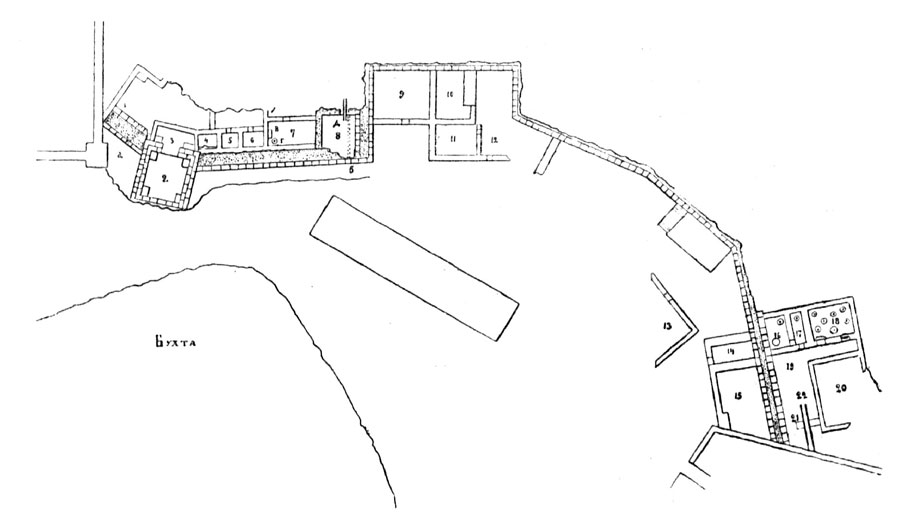
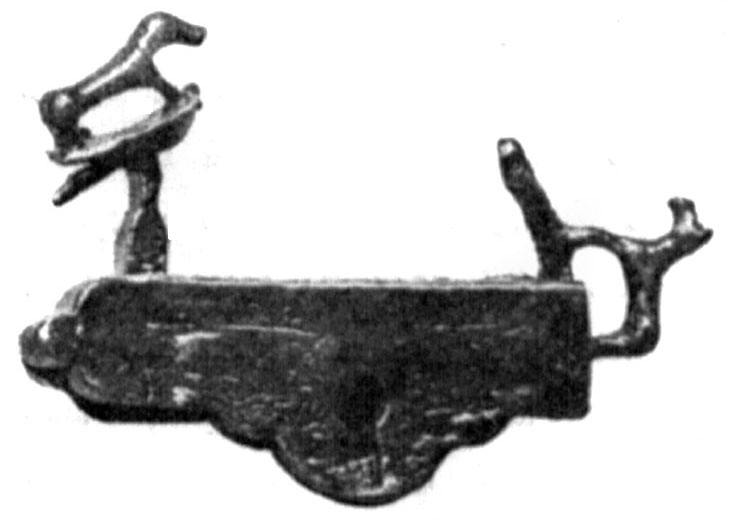
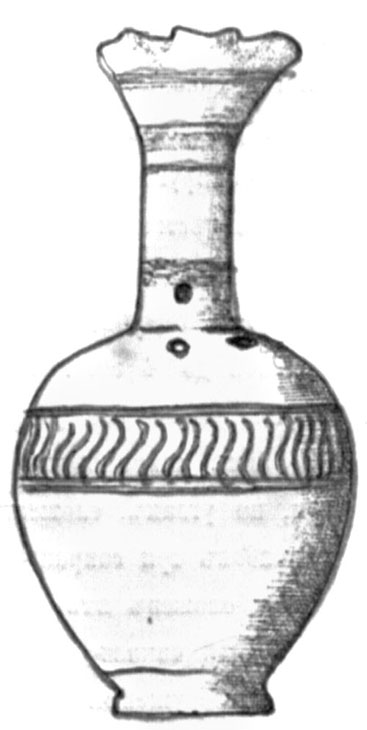
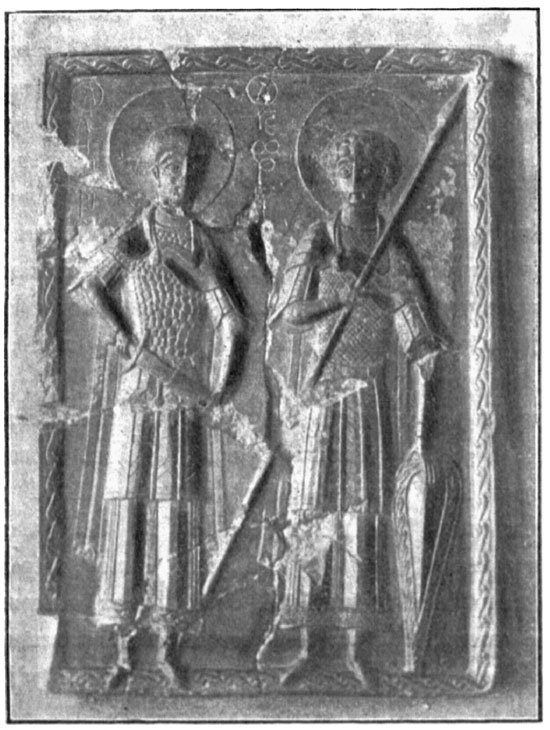


 .
It was found on the coast of the bay amidst shards of earthenware pottery. Plain lamp of red earthenware, with sunken, unreadable Greek inscriptions of 8 letters in one line below. Bottom of black slip vase with 4 letters of Greek name
.
It was found on the coast of the bay amidst shards of earthenware pottery. Plain lamp of red earthenware, with sunken, unreadable Greek inscriptions of 8 letters in one line below. Bottom of black slip vase with 4 letters of Greek name  scratched on it.
Fragment of lead seal, possibly of John bishop of Gothia. There are the following Greek letters in the 2nd and 3rd lines:
scratched on it.
Fragment of lead seal, possibly of John bishop of Gothia. There are the following Greek letters in the 2nd and 3rd lines:  .
.
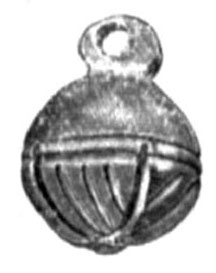
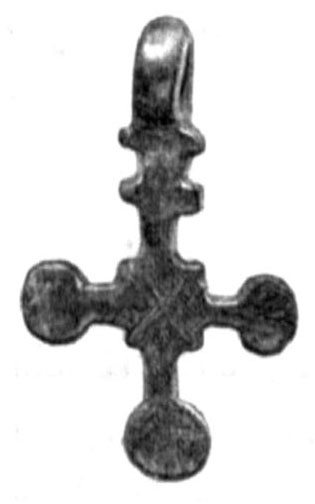
 , below
and XEP above. (Burachkov, <Op. cit., plate> XIV, 14). - Head of Artemis, damaged by rust - Bull, rushing to the right, ХЕР above and
, below
and XEP above. (Burachkov, <Op. cit., plate> XIV, 14). - Head of Artemis, damaged by rust - Bull, rushing to the right, ХЕР above and  below.
It was never published before with this name and bull facing right. For the other names s<ee>: Burachkov, <Op. cit., plate> XIV, №№ 19, 20 and 21. - Head of Artemis in wreath, to the right - Club in wreath, ХЕР below. Of extremely bad preservation (Burachkov, <Op. cit., plate> XIV, 28). Head of Artemis in wreath, to the left - Club in wreath, ХЕР below. Of extremely bad preservation (Burachkov, <Op. cit., plate> XIV, 29). Head of Artemis, damaged by rust - Fish and club, ХЕР below (Burachkov, <Op. cit., plate> XIV, 26). - Head of Artemis to the right - Fish, ХЕР below (Burachkov, <Op. cit., plate> XIV, 27). - The finest of Chersonesos coins -Herales's head to the right - ХЕР, club, and
below.
It was never published before with this name and bull facing right. For the other names s<ee>: Burachkov, <Op. cit., plate> XIV, №№ 19, 20 and 21. - Head of Artemis in wreath, to the right - Club in wreath, ХЕР below. Of extremely bad preservation (Burachkov, <Op. cit., plate> XIV, 28). Head of Artemis in wreath, to the left - Club in wreath, ХЕР below. Of extremely bad preservation (Burachkov, <Op. cit., plate> XIV, 29). Head of Artemis, damaged by rust - Fish and club, ХЕР below (Burachkov, <Op. cit., plate> XIV, 26). - Head of Artemis to the right - Fish, ХЕР below (Burachkov, <Op. cit., plate> XIV, 27). - The finest of Chersonesos coins -Herales's head to the right - ХЕР, club, and  below.
This type was not published with this name before. For the other names, s<ee>: Burachkov, <Op. cit., plate> XV, 54-57. - Of the period under the Roman power: Burachkov, <Op. cit., plate> XVI, no. 91 - 1 sp<ecimen>, no. 94 - 2 sp<ecimens>, no. 96 -3 sp<ecimens>, no. 103-104 - 3 sp<ecimens>, no. 108-114 - 4 sp<ecimens>, no. 118 - 2 sp<ecimens>, no. 120 - 1 sp<ecimen>. - Of the period under Byzantine power: of Justinian I - 3. Of Basilius I - 40. Of Basilius I and Constantine IX - 2. Of Leo VI - 12 (2 lead ones). Leo VI and Alexander - 3 (2 lead ones). Romanus I - 28. Constantine Х - 13. Romanus II - 35; Romanus II and Constantine Х - 16.
Nicephorus Phocas - 3. Basil II - 4, and undeterminable with
below.
This type was not published with this name before. For the other names, s<ee>: Burachkov, <Op. cit., plate> XV, 54-57. - Of the period under the Roman power: Burachkov, <Op. cit., plate> XVI, no. 91 - 1 sp<ecimen>, no. 94 - 2 sp<ecimens>, no. 96 -3 sp<ecimens>, no. 103-104 - 3 sp<ecimens>, no. 108-114 - 4 sp<ecimens>, no. 118 - 2 sp<ecimens>, no. 120 - 1 sp<ecimen>. - Of the period under Byzantine power: of Justinian I - 3. Of Basilius I - 40. Of Basilius I and Constantine IX - 2. Of Leo VI - 12 (2 lead ones). Leo VI and Alexander - 3 (2 lead ones). Romanus I - 28. Constantine Х - 13. Romanus II - 35; Romanus II and Constantine Х - 16.
Nicephorus Phocas - 3. Basil II - 4, and undeterminable with  on the one side and Х on the other - 1. - Lead votive symbols of autonomous period - 10. - Bosporan kings, from Sauromates II onwards - 6. Sinope - 2. Amisos - 1. Caucasian Caesarea - 1. Undeterminable Greek colony, silver coin - 1. - Roman and Byzantine Imperial, most part of extremely bad preservation, uncleanable -224. Oriental - 1 silv<er> and 3 bronze pieces.
on the one side and Х on the other - 1. - Lead votive symbols of autonomous period - 10. - Bosporan kings, from Sauromates II onwards - 6. Sinope - 2. Amisos - 1. Caucasian Caesarea - 1. Undeterminable Greek colony, silver coin - 1. - Roman and Byzantine Imperial, most part of extremely bad preservation, uncleanable -224. Oriental - 1 silv<er> and 3 bronze pieces.
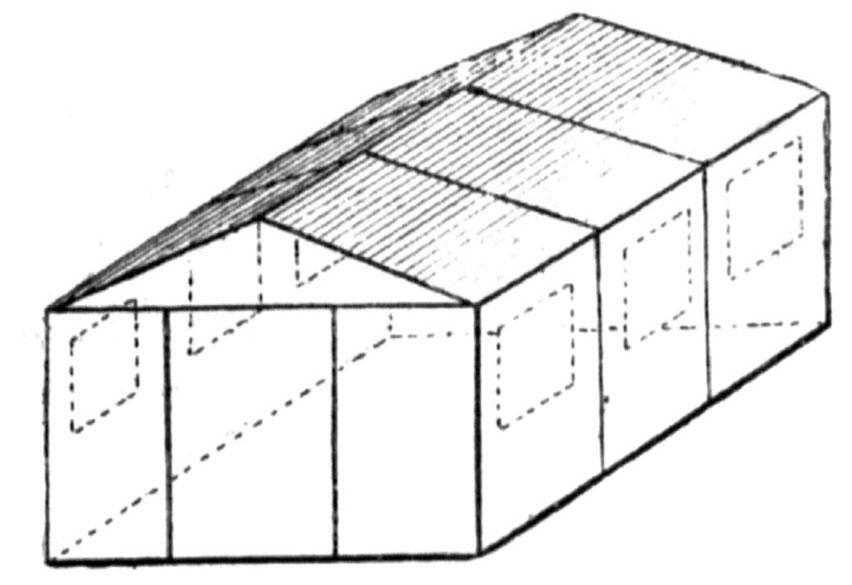
 below; 12 with relief images of: Serapis's head; herma; running boy; boy carrying unclear object; vessel; boy riding dolphin; dolphin with trident; two dolphins; bird sitting on a bow;
below; 12 with relief images of: Serapis's head; herma; running boy; boy carrying unclear object; vessel; boy riding dolphin; dolphin with trident; two dolphins; bird sitting on a bow;
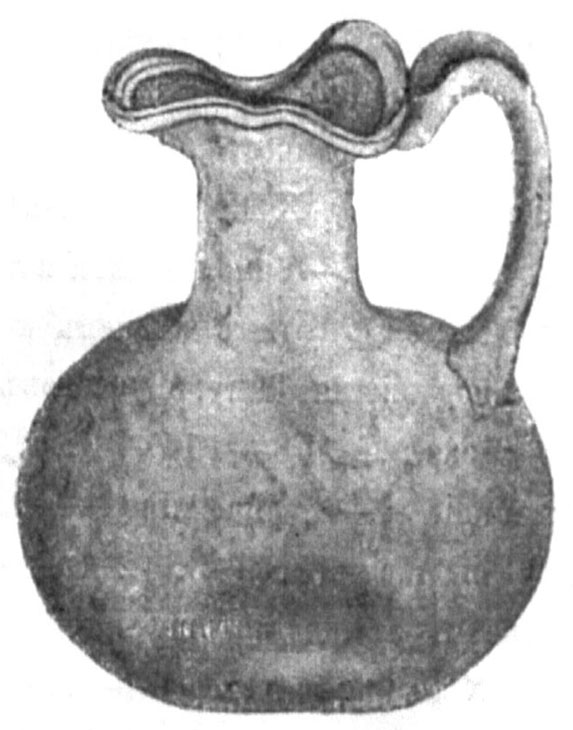
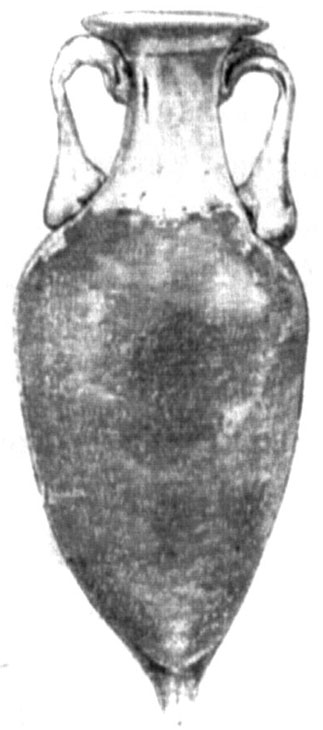

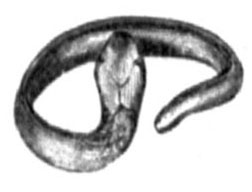

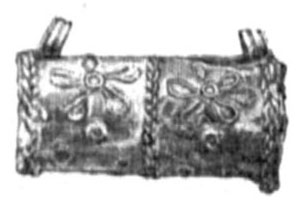
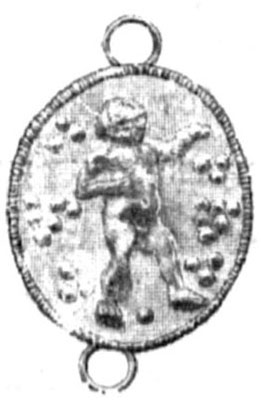

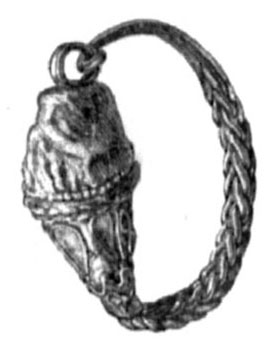

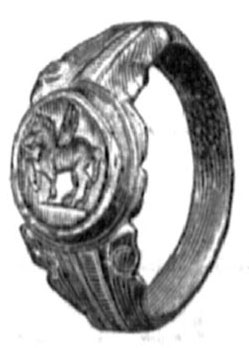

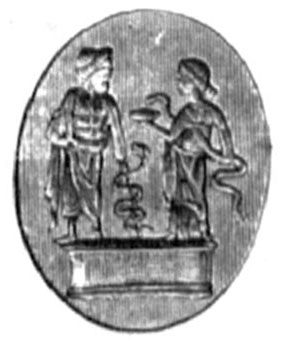
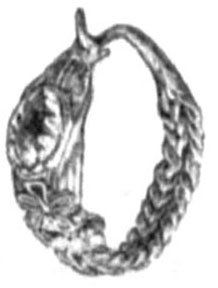
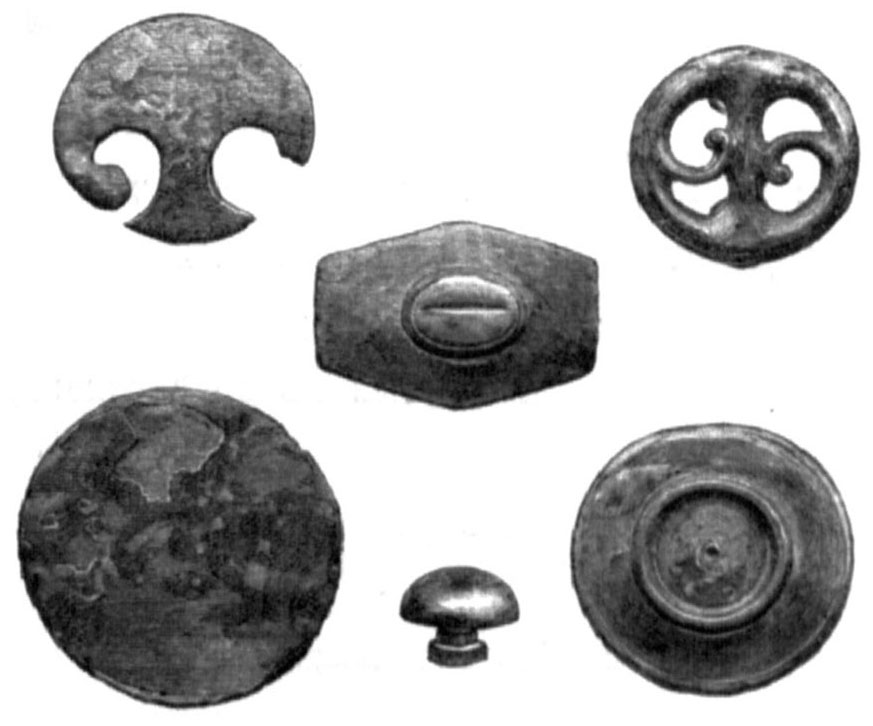

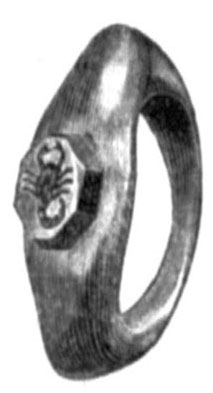
 ,
scratched on it, which is absolutely the same as the urn depicted in 1891 Otchёt Arkheologicheskoy Komissii (Archaeological Commission report), at page 147, under no. 181. Amidst the urns, there were 7 earthenware lamps, 3 of which were plain and 4 had relief images of: head of bearded man with horns; Eros running left; dog standing on lectus, and sitting eagle; double-handled earthenware juglet of beautiful form, 8" high
(
,
scratched on it, which is absolutely the same as the urn depicted in 1891 Otchёt Arkheologicheskoy Komissii (Archaeological Commission report), at page 147, under no. 181. Amidst the urns, there were 7 earthenware lamps, 3 of which were plain and 4 had relief images of: head of bearded man with horns; Eros running left; dog standing on lectus, and sitting eagle; double-handled earthenware juglet of beautiful form, 8" high
(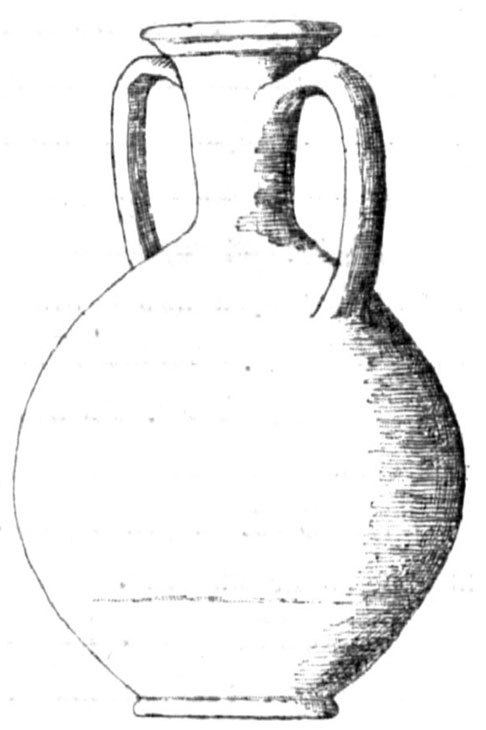
 ,
,
 ,
carved into it; this slab gives the final explanation for the purpose of marble slabs with names of Boiskos, Neomenios, Theagenes, Agathon, and Dioskourios, which were uncovered earlier (in 1891-1893). The distance from this tomb to tomb no. 502 is 8 ½ arch<ines> to the e<ast>.
,
carved into it; this slab gives the final explanation for the purpose of marble slabs with names of Boiskos, Neomenios, Theagenes, Agathon, and Dioskourios, which were uncovered earlier (in 1891-1893). The distance from this tomb to tomb no. 502 is 8 ½ arch<ines> to the e<ast>.
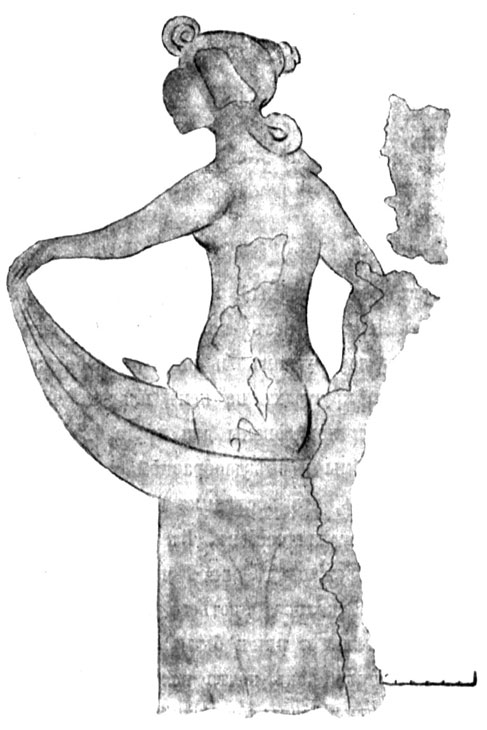

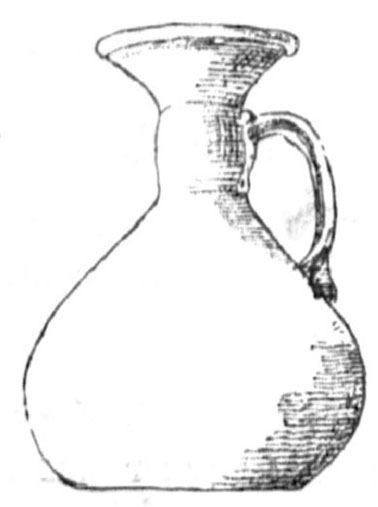
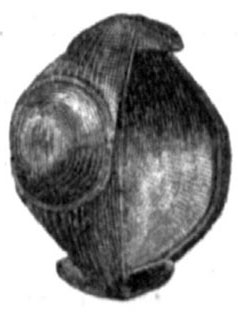
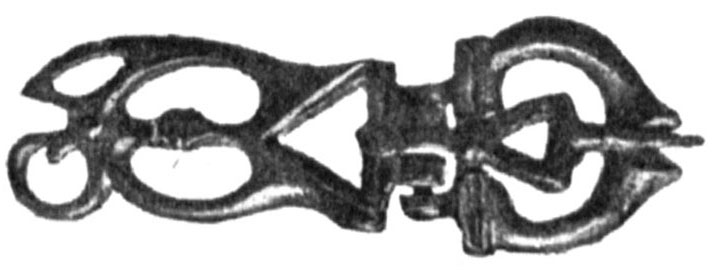
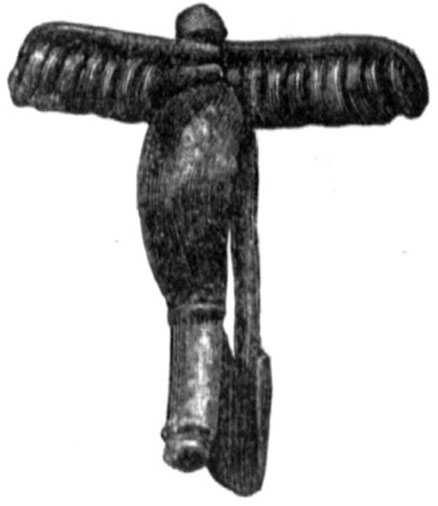
 ;
2 marble lids for small coffins that were possibly used as receptacles of ashes for whole families (there is similar coffin represented in volume 9 of Materialy po Arkheologii Rossii [Materials for the archaeology of Russia], on page 30, under no. 11), 1' 7" and 2' 2 ½" long, and 1' 2" and 1' 7" wide, similar to the lid of marble reliquary uncovered under the floor in chancel of altarless church no. 6 in 1891; head and part of breast of terracotta statuette of a man; stone unpolished hammer, 4 ½" long, 1 ½" wide, and 1 ¾" wide in the middle (the hole for handle was started but not finished); 2 glass bottles 3 ½" and 5 ½" high; 6 earthenware fishing sinkers in the form of truncated pyramids; child's tombstone (?) of sandstone, similar to the ones uncovered in previous years; top part of tombstone of sandstone, 1' 5" х 1' 7", with relief image of draped woman's bust of very rough workmanship (the hair is combed down over the forehead and cut smoothly, there is necklace is put on the neck, and the right hand is clasped to bosom); small fragment of marble slab, 3" х 2" х ½", with 8 letters of Greek inscription in three lines; sandstone gravestone, 3' х 1' х 9", with marble insert, 1' 3 ½" х 9", on which relief image of bust of Roman warrior en face is depicted and abbreviated Latin inscription is carved; the latter consists of 72 letters, 11 digits and leaf at the end, and includes six lines (although stone gravestones with marble inserts were never found prior to the year under report, the description of construction of grave no. 509 allows one to see that this custom in Chersonesos dates from the extreme antiquity and, according to the marble insert that fell out from a similar slab and was described by academician V. V. Latyshev in volume 9 of Materialy po Arkheologii Rossii [Materials for the archaeology of Russia], at page 26 under no. 9, was practiced as early as the fourth century BC). Both the image and the inscriptions are excellently preserved; lower left corner of sandstone gravestone, 11" х 0 - 11" - 0 х 2" (wide), with a fragment of, carelessly and superficially carved, Latin inscription of 24 letters in six lines; ancient Greek grave stele of sandstone, with its top part missing, 2' 4" х 11" х 6", with damaged inscription of 32 letters in four lines (two rosettes located below the inscription are cut off, but, under them, there is still visible painted brooch (?) within band); bottom part of sandstone tombstone, 11" х 6" х 4", with extremely damaged fragment of Greek inscription; bottom part of big marble gravestone, 1' 9" x 11" x 7", with well-preserved part of Greek inscription of 54 letters in three lines; small sandstone tombstone, rounded at the top, 1' 8" х 1' 1" x 6", decorated with circle, carved by compasses, with rosette inside. There is bulge at the bottom of the tombstone with quadrangular slit carved into it, 4" х 2" х 1". Around the hollow with rosette, there was Greek inscription in one line of which 10 letters remained; two silver coins of the emper<ors> Caracalla (211-217) and Julius Philippus (244-249) and 6 amphora handles with Greek inscriptions.
;
2 marble lids for small coffins that were possibly used as receptacles of ashes for whole families (there is similar coffin represented in volume 9 of Materialy po Arkheologii Rossii [Materials for the archaeology of Russia], on page 30, under no. 11), 1' 7" and 2' 2 ½" long, and 1' 2" and 1' 7" wide, similar to the lid of marble reliquary uncovered under the floor in chancel of altarless church no. 6 in 1891; head and part of breast of terracotta statuette of a man; stone unpolished hammer, 4 ½" long, 1 ½" wide, and 1 ¾" wide in the middle (the hole for handle was started but not finished); 2 glass bottles 3 ½" and 5 ½" high; 6 earthenware fishing sinkers in the form of truncated pyramids; child's tombstone (?) of sandstone, similar to the ones uncovered in previous years; top part of tombstone of sandstone, 1' 5" х 1' 7", with relief image of draped woman's bust of very rough workmanship (the hair is combed down over the forehead and cut smoothly, there is necklace is put on the neck, and the right hand is clasped to bosom); small fragment of marble slab, 3" х 2" х ½", with 8 letters of Greek inscription in three lines; sandstone gravestone, 3' х 1' х 9", with marble insert, 1' 3 ½" х 9", on which relief image of bust of Roman warrior en face is depicted and abbreviated Latin inscription is carved; the latter consists of 72 letters, 11 digits and leaf at the end, and includes six lines (although stone gravestones with marble inserts were never found prior to the year under report, the description of construction of grave no. 509 allows one to see that this custom in Chersonesos dates from the extreme antiquity and, according to the marble insert that fell out from a similar slab and was described by academician V. V. Latyshev in volume 9 of Materialy po Arkheologii Rossii [Materials for the archaeology of Russia], at page 26 under no. 9, was practiced as early as the fourth century BC). Both the image and the inscriptions are excellently preserved; lower left corner of sandstone gravestone, 11" х 0 - 11" - 0 х 2" (wide), with a fragment of, carelessly and superficially carved, Latin inscription of 24 letters in six lines; ancient Greek grave stele of sandstone, with its top part missing, 2' 4" х 11" х 6", with damaged inscription of 32 letters in four lines (two rosettes located below the inscription are cut off, but, under them, there is still visible painted brooch (?) within band); bottom part of sandstone tombstone, 11" х 6" х 4", with extremely damaged fragment of Greek inscription; bottom part of big marble gravestone, 1' 9" x 11" x 7", with well-preserved part of Greek inscription of 54 letters in three lines; small sandstone tombstone, rounded at the top, 1' 8" х 1' 1" x 6", decorated with circle, carved by compasses, with rosette inside. There is bulge at the bottom of the tombstone with quadrangular slit carved into it, 4" х 2" х 1". Around the hollow with rosette, there was Greek inscription in one line of which 10 letters remained; two silver coins of the emper<ors> Caracalla (211-217) and Julius Philippus (244-249) and 6 amphora handles with Greek inscriptions.